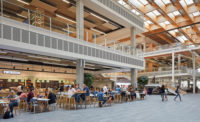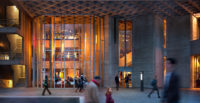London
From Al Jazeera's London broadcast hub on the 16th floor of the Shard, staff and viewers enjoy panoramic skyline views. It was this vantage point that attracted the global media network to the Renzo Piano-designed tower, but its choice created challenges for architects John McAslan + Partners (JMP), which designed reception and workspaces, and Veech x Veech, responsible for the broadcast studio.
Television production involves diverse technical operations with stringent environmental requirements, and JMP had to accommodate these alongside conventional office space within the floor's compact 29,000-square-foot plan. A jigsaw puzzle of control rooms, edit suites, and voice-over booths surrounds the building's central core, wrapped in a sinuous wall of backlit semi-opaque blue glass. Meeting rooms and desks around the perimeter of the floor are bathed in daylight through full-height glazing.
The broadcast studio sits among them. Defined only by a curved backdrop to the news anchors' desk, it is lined by windows on one side and open to the adjacent newsroom and a looping circulation route. Conventional studios are 'black boxes,' but Al Jazeera was determined to incorporate views from the tower in its programming. 'We wanted to show that this is a real space in a real building looking out to a real city,' says designer Stuart A. Veech.
Electric studio lights are sufficiently powerful to achieve a natural-seeming exposure balance with the brightest skies, but daylight levels vary. 'And change is the toughest thing to deal with in TV,' says Veech. To compensate, polarizing filters like those used to darken skies in still photography were applied to both windows and camera lenses. Their effect is almost imperceptible in the space, but allows control of exterior brightness as seen through the lens. At the push of a button, the camera's view of the sky outside can be lightened or darkened in response to variable conditions.
With low camera angles required to catch the view and a ceiling height of just 9 feet, all lighting fixtures, sprinklers and ventilation ducts would be visible on-screen. 'You rarely see a ceiling on TV, so we decided to make it part of the on-air identity,' says Veech. An elliptical ceiling mask conceals much of the equipment and also serves to increase the apparent scale of the small space when seen on screen.
Space restrictions in the congested ceiling zone demanded fewer light fixtures than a conventional studio system, without loss of flexibility. The 80 black cylindrical cans poking through the mask are often used to provide stage lighting for entertainment. The LED fixtures can provide focused or diffuse light, change color temperature, and vary the beam shape. Moreover, since each fixture has a remote-controlled moving head, the system can be shifted silently and instantaneously among preset positions, in response to the exigencies of live television. In the 45-seat newsroom, curved LED panels in the ceiling also provide sufficient illumination for broadcasting. 'It's like heaven when they're all on full power,' says Al Jazeera's global art director, Patrick Bedeau.
The backdrop to the anchors' desk is itself a multipart lighting fixture. Background imagery is fed to a grid of 12 rear-projection cubes, while an adjacent LED wall displays dynamic graphics at low resolution. An inset 85-inch high-resolution screen carries incoming video feeds, and LED strips form accents to the wall and desk.
Another illuminated wall forms the centerpiece of the reception area. Visitors are greeted by a white lightbox through which televisions relay Al Jazeera's global output. Like the dynamic collage of the broadcast studio, it merges the real environment with digital media. Though behind the scenes there is frenetic activity and great technical complexity, the calm coherence perceived by both visitors and viewers owes much to some clever tricks of light.
PeopleClient: Al Jazeera Media Network Owner: Turner & Townsend Project Management Limited Architect: Office: Personnel in architect’s firm who should receive special credit: • Stuart A. Veech, managing partner and creative director • Mascha Veech-Kosmatschof, managing partner and principal architect • Bernhard Trummer, Thomas Milly, Miguel Pereira, design team John McAslan + Partners: John McAslan, principal Consultant(s): Acoustics: Studio Hamburg Atelierbetriebs (studio and newsroom) Project Manager/Cost Consultant: Sweett Group Ltd. Mechanical & Electrical: Zerum Consult Limited (office) Planning Supervisor: Romane Consulting General contractor: Como (office); Studio Hamburg Atelierbetriebs (studio and newsroom) Photographer(s): Hufton + Crow (studio and newsroom) Size: 29,000 square feet (gross) Cost: withheld Completion date: November 2014 |
ProductsInterior finishes Carpet: Milliken (“Juxtapose”) Furnishings Lighting Downlights: Studio Hamburg Aterlierbetriebs (custom “light bands” in newsroom) Task lighting: Studio Hamburg Aterlierbetriebs (custom “light bands” in newsroom) Dimming System or other lighting controls: DMX Add any additional building components or special equipment that made a significant contribution to this project: |








Post a comment to this article
Report Abusive Comment